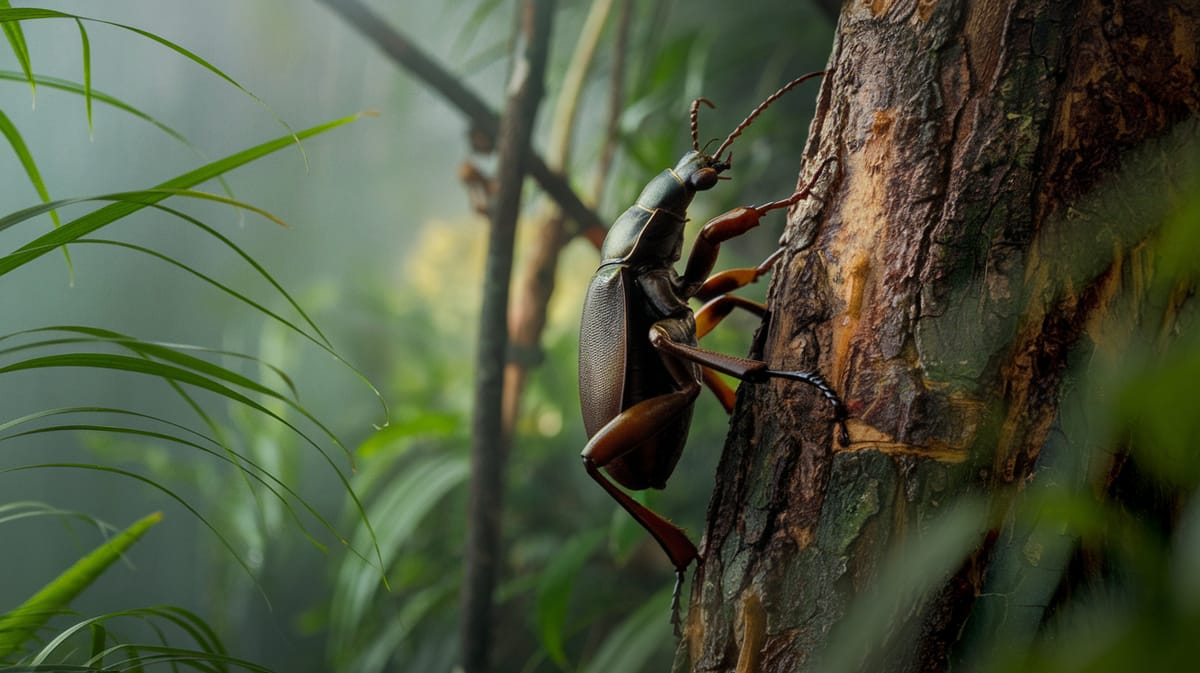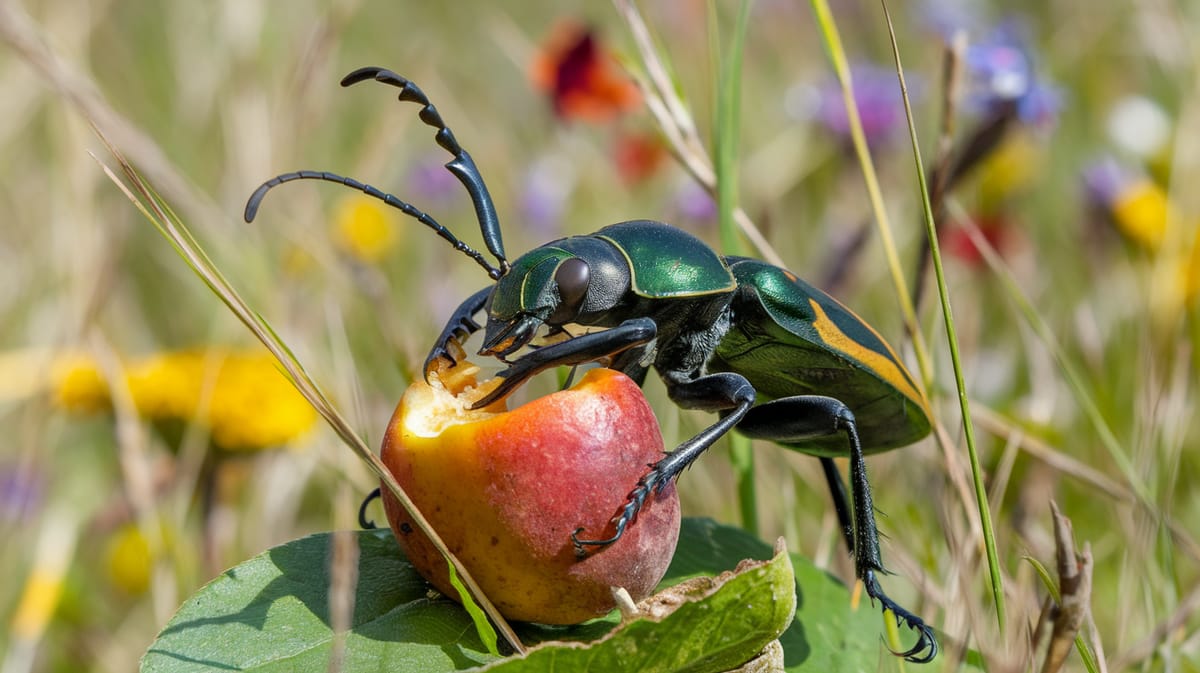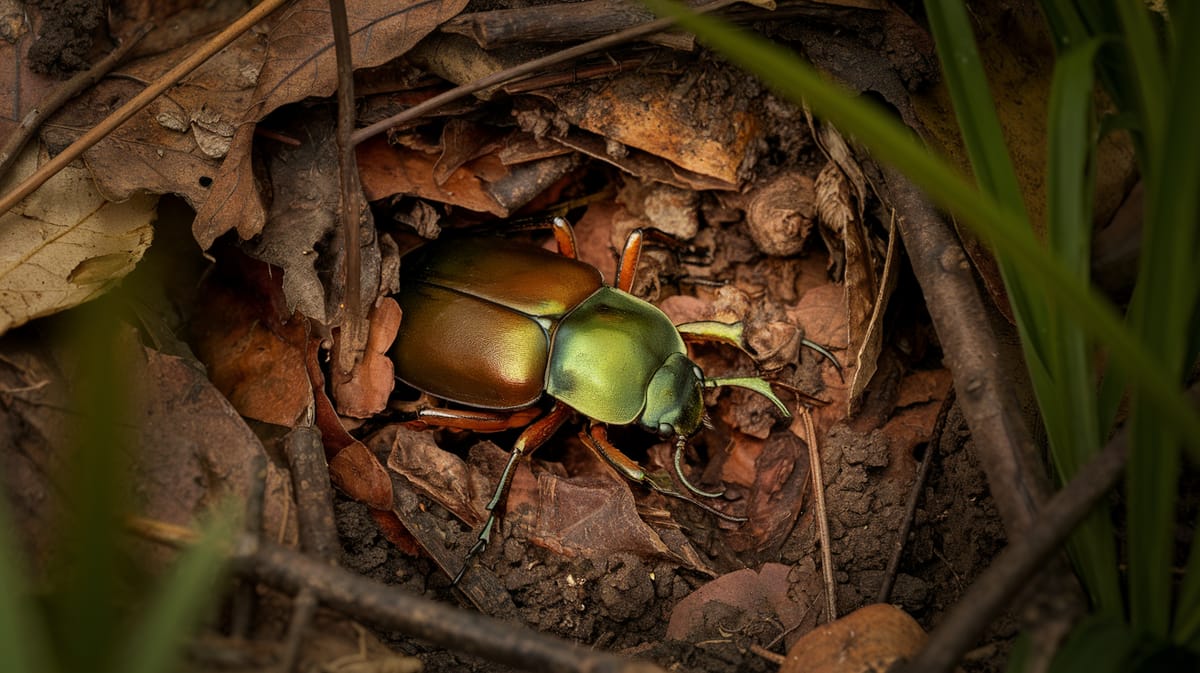Eastern Hercules Beetle
Mighty and resilient, the Eastern Hercules Beetle showcases incredible strength, capable of lifting over 100 times its weight. Its impressive horned appearance makes it a standout in North American forests.

Key Insights at a Glance
Did You Know?
Taxonomy & Classification
The Eastern Hercules Beetle, with its massive horns and striking size, displays fascinating adaptations that reflect its unique evolutionary path within the beetle world. Let's understand the evolutionary journey and classification of these remarkable decomposers.
Global Distribution
Found in the southeastern United States, the Eastern Hercules Beetle thrives in diverse habitats, ranging from forests to subtropical regions.
Evolutionary Adaptations
Surviving since the Cretaceous period, these beetles have developed robust exoskeletons and horns, aiding in their survival and competitive mating strategies.
Lifecycle and Growth
A remarkable journey of transformation from Egg to Adult.
Egg
Eggs are laid in decaying wood, where they remain protected as embryos develop into larvae.
Larva
Larvae feed on rotting wood, growing significantly as they molt multiple times before entering the pupal stage.
Pupa
Pupation occurs in a cocoon made from soil and wood particles, facilitating the transformation into an adult beetle.
Adult
Adults emerge with distinctive horns and strong wings, engaging in mating and dispersing to new areas.
Dietary Habits
A primarily herbivorous feeder, this beetle consumes decaying plant material, utilizing strong mandibles for efficient processing.
| DIET TYPE | DESCRIPTION |
|---|---|
| Primary Diet | Feeds mainly on rotting wood, utilizing its mandibles to break down decaying plant fibers efficiently. |
| Secondary Diet | Consumes plant sap and fruit juices, supplementing its diet with these additional sources when available. |
| Occasional | Occasionally ingests animal matter from decomposing carcasses, exhibiting opportunistic feeding behavior in nutrient-poor environments. |

Behaviour and Adaptations
Discover the incredible traits that define the Eastern Hercules Beetle's survival and adaptation in its environment.
Strength and Power
Uses immense strength to move objects many times its weight.
Nocturnal Activity
Active under the cover of darkness to avoid predators and maximize feeding.
Color Change
Shell changes color with humidity, providing camouflage.
Ecosystem Impact
Understanding how Eastern Hercules Beetles contribute to ecological balance and sustainability.
Nutrient Recycler
Breaks down decaying wood, enriching soil with nutrients.
Forest Decomposer
Assists in forest litter decomposition, promoting plant growth.
Biodiversity Supporter
Provides food for predators, maintaining ecosystem balance.
Conservation Challenges
Understanding and addressing the major threats to Eastern Hercules Beetle populations.
Habitat Loss
Deforestation and urbanization reduce crucial habitats for survival.
Chemical Exposure
Pesticides harm beetle larvae and adult beetles.
Climate Change
Changing weather patterns disrupt beetle breeding cycles.
Frequently Asked Questions
How long do Eastern Hercules Beetle live?
Eastern Hercules Beetles typically live for three to six months as adults. Their larval stage can last up to two years, depending on environmental conditions. After pupating, they emerge as adults and live for a few months before completing their life cycle.
What do Eastern Hercules Beetle eat?
Eastern Hercules Beetles primarily feed on decaying wood and plant matter during their larval stage. As adults, they consume tree sap, overripe fruits, and occasionally nectar. Their diet plays a crucial role in nutrient recycling within forest ecosystems.
Are Eastern Hercules Beetle poisonous?
Eastern Hercules Beetles are not poisonous. They are harmless to humans and pose no threat. While their large size and horns might appear intimidating, they do not have any toxic defense mechanisms or venomous bites.
Are Eastern Hercules Beetle endangered?
Eastern Hercules Beetles are not considered endangered. They are relatively common in their natural habitats, which include forests in the southeastern United States. Conservation efforts and habitat preservation help maintain their population stability.
What do Eastern Hercules Beetle symbolize?
Eastern Hercules Beetles often symbolize strength and resilience due to their impressive size and ability to lift heavy weights relative to their body size. They are also associated with transformation, as they undergo significant changes from larvae to adults.
Do Eastern Hercules Beetle bite?
Eastern Hercules Beetles do not bite humans. They are gentle giants and are not aggressive. Their mandibles are used mainly for feeding on decaying plant material and not for defense or attacking threats.
What color are Eastern Hercules Beetle?
Eastern Hercules Beetles are typically olive green with black spots. The coloration can vary slightly, with some individuals appearing more brownish or yellowish. Their colorful shells help them blend into their forest environment.
Does a Eastern Hercules Beetle have wings?
Yes, Eastern Hercules Beetles have wings. They possess two pairs: the hard outer elytra and the membranous hind wings underneath. Despite their large size, they are capable of flight, though they are not agile fliers.
What does a Eastern Hercules Beetle look like?
Eastern Hercules Beetles are large, robust insects with a distinctive horn on the males' heads. They have a shiny, smooth exoskeleton with an olive green color and black spots. Males are larger than females and have longer horns.
Is a Eastern Hercules Beetle an insect?
Yes, the Eastern Hercules Beetle is an insect. It belongs to the order Coleoptera, which includes beetles. Like all insects, they have a three-part body structure: head, thorax, and abdomen, and six legs.
Related Insects
Discover insects with similar characteristics to Eastern Hercules Beetle - including shared habitats, diets, and taxonomic classifications
Share this profile
Help others discover Eastern Hercules Beetle
